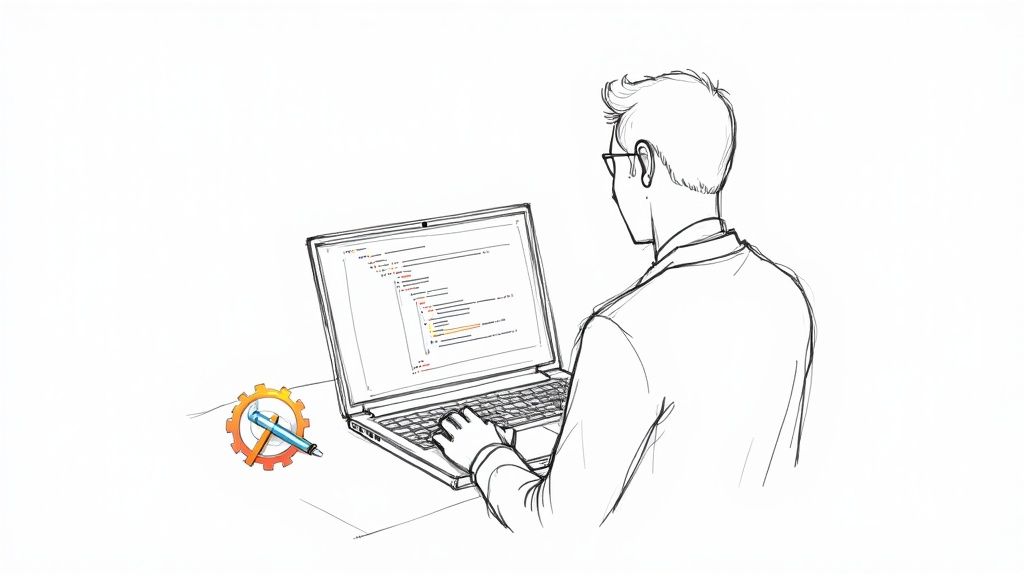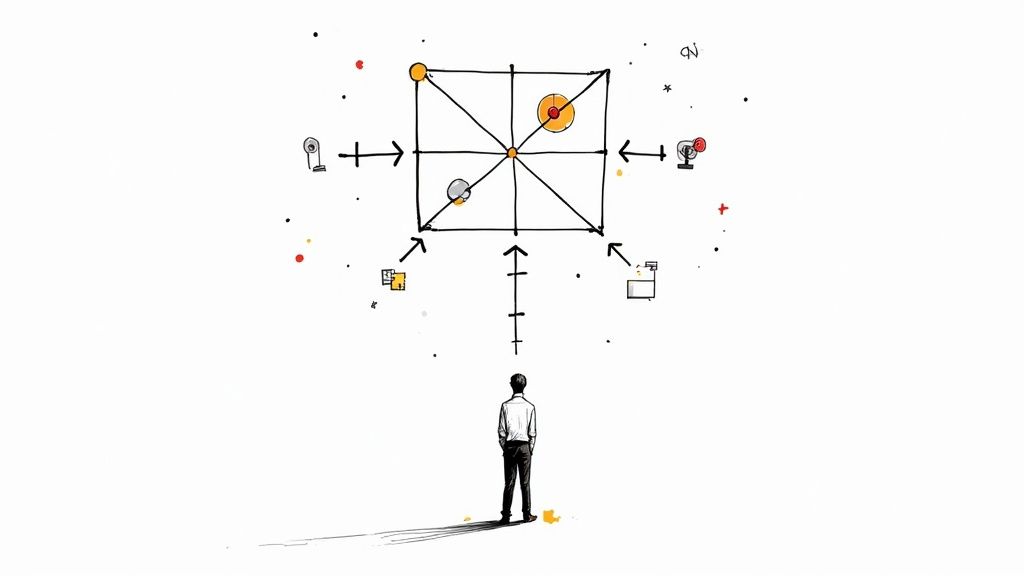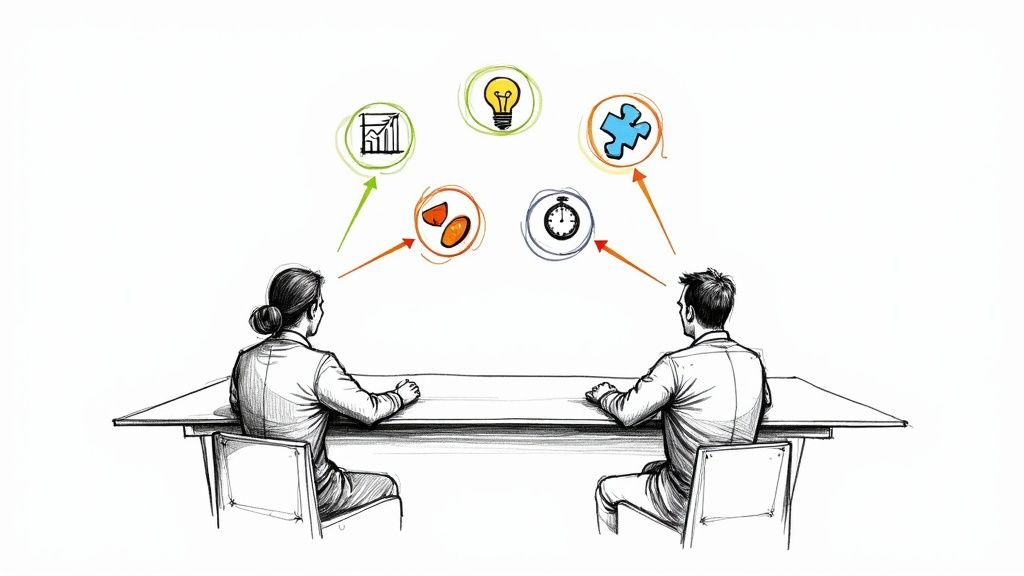In today's competitive talent market, relying solely on resumes and unstructured interviews is a high-risk gamble. The cost of a bad hire is higher than ever, impacting everything from team morale and productivity to your bottom line. To build a resilient, high-performing workforce, you need a robust, data-driven approach. This is where strategic candidate assessment methods come into play. They provide the objective insights necessary to look past a candidate's self-reported skills and accurately predict their future success within your unique organizational culture.
Moving beyond generic advice, this guide offers a detailed roundup of the most effective assessment techniques used by leading companies. We'll explore the science and practical application behind each method, delivering actionable insights to refine your recruitment strategy.
Here’s what you’ll gain from this comprehensive list:
- A deep dive into nine proven assessment tools, from structured interviews to work sample tests.
- Practical implementation tips to seamlessly integrate these methods into your existing workflow.
- A balanced view of the pros and cons for each technique, helping you choose the right tools for specific roles.
- Guidance on combining methods, including how asynchronous video interviews can enhance your process, to create a holistic evaluation framework.
Get ready to transform your hiring process from a game of chance into a strategic advantage. Let's explore the tools that will help you identify and secure top-tier talent with precision and confidence.
1. Structured Behavioral Interviews: The Gold Standard for Fairness
A structured behavioral interview is a systematic, evidence-based approach where every candidate is asked the same set of predetermined questions. This method operates on a simple yet powerful premise: past behavior is the best predictor of future performance. Unlike unstructured, conversational interviews that can be swayed by rapport or unconscious bias, this method is one of the most reliable and legally defensible candidate assessment methods available.
The process involves developing questions tied directly to specific, job-relevant competencies, such as problem-solving, collaboration, or leadership. For example, Amazon famously frames its behavioral questions around its 14 Leadership Principles, asking candidates for concrete examples of how they’ve demonstrated these values. Similarly, Google’s renowned hiring process relies heavily on structured interviews to assess cognitive ability and role-related knowledge with consistency.
How to Implement Structured Interviews
To make this method effective, focus on consistency and objectivity. Your goal is to create a level playing field where every candidate is evaluated against the exact same criteria.
- Develop Competency-Based Questions: Identify the core skills needed for the role. Craft questions that prompt candidates to share specific stories using the STAR method (Situation, Task, Action, Result). For a project manager role, you might ask, "Tell me about a time a project was behind schedule. What was the situation, what actions did you take, and what was the outcome?"
- Create a Standardized Scoring Rubric: Build a simple rating scale (e.g., 1-5) for each question. Define what a poor, average, and excellent answer looks like based on the target competencies. This minimizes subjectivity and ensures all interviewers score consistently.
- Train Your Interviewers: All interviewers must understand the process, the questions, and how to use the scoring rubric. Training reduces "interviewer drift" where interviewers revert to old, unstructured habits.
For a quick reference, this infographic summarizes the core components of a successful structured interview process.
These three elements work together to create a robust framework that removes guesswork and focuses the evaluation on job-relevant evidence. Asynchronous video interviews are particularly well-suited for this approach, allowing you to deliver the same set of structured questions to every applicant, who can then record their STAR-based answers for standardized review.
2. Cognitive Ability Tests: Measuring Raw Problem-Solving Power
Cognitive ability tests are standardized assessments designed to measure a candidate's general mental aptitude, including their capacity for reasoning, problem-solving, numerical analysis, and learning agility. These tests evaluate how well an individual can process information, think critically, and adapt to new challenges, making them a powerful predictor of job performance, especially for complex roles. As one of the most statistically valid candidate assessment methods, they offer an objective look at a candidate's raw intellectual horsepower.
This approach is widely used across various industries to forecast a candidate's potential to succeed. For instance, the Wonderlic Personnel Test has been famously used by the NFL and many corporations to quickly gauge trainability. Similarly, consulting and legal firms often rely on assessments like the Watson-Glaser Critical Thinking Appraisal to identify candidates who excel at logical reasoning and evaluating arguments, skills that are central to those professions.
How to Implement Cognitive Ability Tests
To leverage this method effectively, the focus must be on relevance, fairness, and integration with other assessment data. Your goal is to gain an objective measure of aptitude without introducing bias or creating a poor candidate experience.
- Ensure Job Relevance and Validity: Only use tests that have been validated to predict performance for the specific job family you are hiring for. A test measuring abstract reasoning, like Raven's Progressive Matrices, might be highly relevant for a software engineer but less so for a sales role.
- Combine with Other Assessment Methods: Cognitive ability tests are most powerful when used as one data point among several. Pair them with structured interviews and skills assessments to build a holistic view of the candidate, evaluating their aptitude alongside their experience and interpersonal skills.
- Monitor for Adverse Impact: Regularly analyze test results across demographic groups to ensure the assessment is not unintentionally creating barriers for any protected class. Be prepared to adjust your process or use alternative validated tests if you identify any bias.
These steps ensure you are using cognitive tests ethically and effectively, adding a layer of objective data to your hiring decisions. By automating the delivery and scoring of these assessments, you can significantly streamline the top-of-funnel screening process, as discussed in our guide on automated candidate screening. This allows your team to focus on candidates who not only have the right experience but also the cognitive ability to thrive.
3. Assessment Centers: A High-Fidelity Simulation of Job Performance
An assessment center is a comprehensive evaluation program where candidates participate in multiple exercises designed to simulate the challenges they would face on the job. Rather than relying on what candidates say they can do, this method observes their actual behavior in action. Trained assessors evaluate participants against a standardized set of job-relevant competencies, making it one of the most predictive candidate assessment methods for complex roles.
Pioneered by organizations like AT&T for management development and now used globally by companies like Procter & Gamble and IBM for leadership and graduate recruitment, assessment centers provide a holistic view of a candidate's abilities. The British Army, for instance, uses a multi-day assessment center to select its officers, evaluating everything from leadership and teamwork to physical and mental resilience through a series of practical tests.

How to Implement Assessment Centers
A successful assessment center requires careful design, rigorous training, and consistent execution. Your goal is to create a realistic yet controlled environment to see how candidates perform under pressure.
- Design Job-Relevant Exercises: Create activities that mirror the actual demands of the role. For a sales manager, this could include a role-playing exercise for handling a difficult client, a group discussion to solve a business case, and an in-tray exercise to prioritize tasks.
- Train Your Assessors Thoroughly: Assessors must be experts in observing behavior and using the scoring rubric without bias. Training should cover the specific competencies being measured and how to provide objective, evidence-based ratings.
- Use Multiple Exercises and Assessors: To ensure reliability, evaluate each competency across several different exercises. Having multiple assessors observe each candidate helps to average out individual biases and provides a more rounded, accurate final score.
These elements combine to create a powerful, predictive assessment tool ideal for senior, leadership, or other high-impact roles where the cost of a bad hire is significant. While traditionally conducted in person, many components like role-playing and case studies can be adapted for a virtual format using video platforms, allowing for a "digital assessment center" that saves time and logistical costs.
4. Work Sample Tests: Evaluating Performance in Action
Work sample tests are performance-based assessments that require candidates to complete tasks mirroring the actual work they would perform on the job. This method directly measures hands-on skills and abilities in a realistic context, making it one of the most predictive candidate assessment methods for job performance. Instead of asking how a candidate would do something, you watch them do it.
This approach, championed by industrial-organizational psychologist Robert Guion and now a staple in tech and creative industries, bridges the gap between claims on a resume and actual capability. For instance, tech giants like Google and Facebook rely on coding challenges to vet software developers, while creative agencies use portfolio reviews and trial projects to assess designers. Similarly, consulting firms use case study presentations to gauge a candidate's analytical and problem-solving skills in a high-stakes environment.

How to Implement Work Sample Tests
To ensure fairness and accuracy, a work sample test must be carefully designed to reflect core job duties without being overly burdensome. The goal is to create a microcosm of the role.
- Design Job-Relevant Tasks: Identify the most critical functions of the position. Create a concise task that represents these duties, such as asking a sales candidate to prepare a mock sales presentation or a content writer to draft a short blog post.
- Provide Clear Instructions and Resources: Give every candidate the exact same instructions, context, and tools needed to complete the task. Ambiguity can lead to inconsistent performance that doesn't reflect true ability.
- Develop Standardized Evaluation Criteria: Create a scoring rubric before you administer the test. Define what success looks like for specific criteria, like code efficiency, design creativity, or communication clarity. This ensures objective, consistent scoring across all candidates.
These tests are exceptionally well-suited for roles where practical skills are paramount. You can integrate them into your process by sending a standardized work sample challenge through an asynchronous video platform, where candidates can explain their approach and showcase their final product for a comprehensive review.
5. Personality Assessments: Uncovering Workplace Behaviors
Personality assessments are psychometric tools designed to measure a candidate's stable traits, behavioral tendencies, and core motivations. This method is based on the principle that specific personality dimensions can predict how an individual is likely to behave in different work situations, interact with colleagues, and respond to stress. Unlike assessments focused on skills or knowledge, these tools provide insight into a candidate's inherent "how" and "why," making them one of the most revealing candidate assessment methods for predicting cultural fit and long-term job satisfaction.
Pioneered by figures like Joyce and Robert Hogan, who developed the Hogan Personality Inventory for leadership, and William Marston, whose theories underpin the DISC assessment, these tools are now staples in many industries. For example, a company might use a Caliper Profile to identify sales candidates with high assertiveness and persuasion, or the Big Five model to find conscientious and agreeable individuals for collaborative, detail-oriented roles. These assessments help build a holistic candidate profile that goes beyond what a resume can show.
How to Implement Personality Assessments
To leverage this method effectively, you must ensure the process is valid, relevant, and used as part of a broader evaluation strategy. The goal is to gain predictive insights, not to label or stereotype candidates.
- Use Validated, Job-Relevant Instruments: Select assessments that are scientifically validated and proven to be reliable. More importantly, focus on the specific personality dimensions that are directly relevant to success in the role. For instance, openness to experience is crucial for creative roles, while conscientiousness is a strong predictor across most jobs.
- Combine with Other Assessment Methods: Never make a hiring decision based solely on a personality test. These tools are most powerful when their insights are combined with data from structured interviews, skills tests, and work samples. This creates a balanced view and helps verify the traits identified in the assessment.
- Train Assessors in Proper Interpretation: Raw scores from a personality test are meaningless without proper context. Ensure that your HR team or hiring managers are trained to interpret the results correctly and understand the nuances of what each trait means in a professional setting.
These steps ensure that personality assessments are used ethically and effectively, providing a valuable layer of information to your hiring process. When used thoughtfully, they can significantly improve hiring outcomes by aligning a candidate's natural behavioral style with the demands of the job and the culture of the organization.
6. Situational Judgment Tests (SJTs): Gauging Real-World Decision-Making
Situational Judgment Tests (SJTs) present candidates with realistic, hypothetical work-related scenarios and ask them to identify the most effective course of action from a list of possible responses. This method moves beyond what a candidate says they would do and assesses their actual judgment, problem-solving skills, and alignment with organizational values. As powerful candidate assessment methods, SJTs excel at predicting performance in roles that require complex decision-making under pressure.
Their effectiveness is well-documented across various high-stakes professions. For example, the CASPer test is a widely used SJT for medical school admissions to evaluate ethics and professionalism. Similarly, they are a staple in selection processes for law enforcement, customer service representatives, and management trainees, where on-the-spot judgment is a critical job component. The core principle is that how a person handles a simulated challenge reveals their inherent behavioral tendencies and practical intelligence.
How to Implement Situational Judgment Tests
An effective SJT is built on realism and relevance. The scenarios must accurately reflect the challenges an employee will face, and the response options must be plausible.
- Develop Scenarios from Critical Incidents: Work with subject matter experts and high-performing incumbents to identify real-life "critical incidents." These are challenging situations where an employee's response significantly impacts the outcome. For a customer service role, a scenario might involve an angry customer with an unsolvable problem.
- Create Realistic Response Options: For each scenario, develop a set of potential actions. These should range from highly effective to ineffective or even counterproductive. Avoid obviously "right" or "wrong" answers to better gauge a candidate's nuanced judgment.
- Establish a Clear Scoring Key: Involve subject matter experts to rate the effectiveness of each response option. This creates a standardized scoring guide that can be applied consistently to all candidates, ensuring objective evaluation and removing guesswork from the assessment process.
These steps ensure your SJT is not just a theoretical exercise but a valid predictor of on-the-job performance. You can deliver these tests efficiently using online assessment platforms or even integrate them into an asynchronous video interview, where candidates explain their reasoning for choosing a specific action, adding another layer of insight into their thought process.
7. Technical Skills Assessments: Measuring Hands-On Expertise
Technical skills assessments are specialized evaluations designed to objectively measure a candidate's hands-on abilities and theoretical knowledge in specific domains. These tests move beyond self-reported skills on a resume to verify actual proficiency. This approach is one of the most direct candidate assessment methods for roles where specific technical know-how is non-negotiable, ensuring that candidates possess the foundational skills to succeed from day one.
This method has become standard practice in the technology industry, where companies need to validate complex competencies. For example, coding platforms like HackerRank and Codility provide standardized challenges to assess developers' problem-solving and coding efficiency. Similarly, companies hiring cloud architects use assessments based on Microsoft Azure or AWS environments, while creative roles are often evaluated using tests for Adobe Creative Suite proficiency. These assessments provide concrete evidence of a candidate's capabilities.
How to Implement Technical Skills Assessments
To get reliable results, your assessments must be relevant, fair, and reflective of the actual job. The goal is to measure practical ability, not just academic knowledge.
- Align with Real-World Tasks: Design assessments that mirror the challenges the employee will face. Instead of asking abstract questions, present a realistic problem-solving scenario. For a data analyst, provide a sample dataset and ask them to derive specific insights.
- Balance Theory and Application: A great assessment tests both foundational concepts and the ability to apply them. Include a mix of multiple-choice questions on key principles and a practical task that requires the candidate to build, fix, or analyze something.
- Use Industry-Standard Tools: Whenever possible, conduct the assessment using the same software and environments the employee will use on the job. This not only tests relevant skills but also evaluates the candidate's familiarity with the professional toolkit.
These elements ensure your technical assessment is a powerful predictor of on-the-job performance rather than a simple trivia quiz. The key is to create a simulation that is as close to the real work as possible, providing a clear and defensible measure of a candidate's technical fit for the role.
8. Video Interviews: Expanding Access and Efficiency
Video interviews are assessments conducted using video technology, offering a flexible and scalable alternative to in-person meetings. This method falls into two main categories: live interviews, where candidates and interviewers connect in real-time via platforms like Zoom or Google Meet, and asynchronous (one-way) interviews, where candidates record their answers to preset questions on their own time. Accelerated by the global shift to remote work, video interviews have become indispensable candidate assessment methods for modern talent acquisition.
Platforms like HireVue and Spark Hire have pioneered asynchronous video interviewing, allowing companies to screen a high volume of candidates efficiently. The key benefit is the ability to overcome geographical barriers and scheduling conflicts, widening the talent pool significantly. A well-structured video interview, particularly an asynchronous one, can be combined with behavioral questions to ensure every candidate receives the exact same prompts, creating a standardized initial screening process.
How to Implement Video Interviews
Success with video interviews hinges on creating a positive and fair candidate experience while ensuring the technology serves, rather than hinders, the assessment process.
- Provide Clear Technical Instructions: Don't assume every candidate is a tech expert. Send a detailed guide beforehand explaining how to access the platform, test their camera and microphone, and who to contact for technical support. This reduces candidate anxiety and prevents technical glitches from disrupting the interview.
- Train Interviewers on Virtual Best Practices: Interviewing on video requires different skills. Train your team to maintain eye contact by looking at the camera, use clear and encouraging body language, and avoid multitasking. For asynchronous reviews, teach them to focus solely on the content of the answer, using a standardized rubric to score responses.
- Offer Flexibility and Have a Backup Plan: For live interviews, be considerate of different time zones. For asynchronous interviews, provide a generous window for completion (e.g., 48-72 hours). Always have a backup, such as a phone number to dial into, in case of a total technology failure.
This approach ensures that your video interview process is not just a logistical tool but a powerful and equitable assessment method. One-way video interviews are particularly effective at the top of the funnel, allowing you to consistently evaluate core competencies across a large applicant pool before investing time in live conversations. You can learn more about how to achieve smart hiring with on-demand asynchronous interviews.
9. Reference Checks and Background Verification: Validating Past Performance
Reference checks and background verification are a crucial final-stage due diligence step, moving from what candidates say they can do to what they have actually done. This systematic process involves contacting previous employers and professional connections to confirm a candidate's employment history, skills, and work ethic. While not predictive in the same way as a work sample, it is one of the most important candidate assessment methods for mitigating risk and ensuring a truthful hire.
This method goes beyond simple employment verification. When done correctly, it provides qualitative insights into a candidate's character, reliability, and collaborative style. Companies like HireRight and Sterling offer comprehensive background screening services, while internal HR departments often conduct detailed reference calls to gather nuanced feedback. The goal is to corroborate the information gathered throughout the hiring process and uncover any potential red flags before an offer is finalized.
How to Implement Effective Reference Checks
The key to a valuable reference check is to move beyond generic questions and dig for specific, performance-related evidence. Your objective is to get a well-rounded picture of the candidate in a professional context.
- Ask Specific, Behavioral-Based Questions: Instead of asking, "Was she a good employee?" ask, "Can you describe a situation where she had to manage a tight deadline? How did she handle it?" This prompts the reference to provide concrete examples, similar to a behavioral interview.
- Verify Reference Authenticity: Always confirm the reference's identity and their professional relationship to the candidate. Ask how long they worked together and in what capacity. Contacting a former direct manager will yield more valuable insights than a former peer.
- Focus on Job-Relevant Competencies: Tailor your questions to the key skills required for the new role. If the job requires strong client management skills, ask the reference to describe the candidate’s approach to handling difficult customers.
- Document Everything: Keep detailed, objective notes of every conversation. This documentation is vital for demonstrating a fair and consistent process, especially for compliance and legal purposes.
This structured approach transforms reference checks from a simple box-ticking exercise into a powerful validation tool. To explore this topic further, you can learn more about how to build a comprehensive pre-employment screening process on asyncinterview.io. These checks serve as a final quality control measure, providing peace of mind and protecting the organization from potential bad hires.
Candidate Assessment Methods Comparison
| Assessment Method | Implementation Complexity 🔄 | Resource Requirements ⚡ | Expected Outcomes 📊 | Ideal Use Cases 💡 | Key Advantages ⭐ |
|---|---|---|---|---|---|
| Structured Behavioral Interview | High – requires question development and interviewer training | Moderate to High – multiple interviewers, scoring rubrics | Reliable prediction of job performance; consistent candidate evaluation | Competency-based roles; legal defensibility needed | Reduces bias; standardized; better candidate experience |
| Cognitive Ability Tests | Moderate – test selection and validation needed | Low to Moderate – standardized tests, scoring automation | Strong predictor of general job performance and learning ability | Broad job types; screening for general ability | Cost-effective; objective; scalable |
| Assessment Centers | Very High – complex exercises, assessor training, coordination | Very High – multiple assessors, facilities, time-intensive | Comprehensive competency evaluation; good for leadership roles | Managerial/senior roles needing multi-competency assessment | High predictive validity; realistic job preview |
| Work Sample Tests | High – design realistic tasks and evaluation criteria | Moderate to High – SME involvement, test administration | Direct demonstration of job-relevant skills and performance | Skilled roles needing hands-on ability demonstration | High face validity; job relevant; candidate satisfaction |
| Personality Assessments | Moderate – selection and validation of instruments | Low to Moderate – standardized questionnaires | Insights into behavioral tendencies, cultural fit, and motivation | Team fit, leadership, interpersonal roles | Quick; cost-effective; identifies development needs |
| Situational Judgment Tests (SJTs) | Moderate – scenario creation and validation | Low to Moderate – test administration and scoring | Measures judgment and decision-making in job contexts | Roles requiring practical judgment and values fit | High candidate acceptance; cost-effective |
| Technical Skills Assessments | High – requires technical expertise and regular updates | Moderate to High – specialized tools and test development | Accurate measure of job-specific technical skills | Technical and specialized roles | Direct skill measurement; objective results |
| Video Interviews | Low to Moderate – setup and training for digital platforms | Low to Moderate – tech infrastructure and scheduling | Convenient remote evaluation; scalable interview process | Remote hiring; volume recruitment | Cost-effective; scalable; geographic flexibility |
| Reference Checks & Background Verification | Low to Moderate – contacting references and verifying info | Low – phone/email, third-party services | Verification of past performance and character insights | All roles as final validation step | External validation; cost-effective; reveals red flags |
Building Your High-Impact Assessment Toolkit
Navigating the landscape of candidate assessment methods can feel overwhelming, but as we've explored, the goal isn't to master all nine at once. The true power lies in strategically curating a multi-layered assessment process tailored to the specific demands of each role. Moving beyond a gut-feel approach to hiring is no longer just an advantage; it's a necessity for building resilient, high-performing teams. The methods detailed in this guide, from structured interviews to work sample tests, represent the essential building blocks for creating an objective, effective, and fair recruitment engine.
The core principle to remember is triangulation. No single method is a silver bullet. A brilliant score on a cognitive ability test doesn't guarantee a good team fit, just as a charming interview doesn't guarantee technical competence. By combining different types of assessments, you create a more complete and predictive picture of a candidate's potential. This approach allows you to verify strengths and identify potential red flags from multiple angles, dramatically increasing the odds of a successful hire.
Key Insight: The most effective hiring strategies don't rely on a single data point. They layer complementary candidate assessment methods to build a holistic, evidence-based profile of each applicant, ensuring decisions are based on capability, not charisma.
From Theory to Action: Your Next Steps
The transition from understanding these methods to implementing them requires a thoughtful, step-by-step approach. Rather than overhauling your entire process overnight, focus on incremental improvements.
Here is a practical roadmap to get started:
-
1. Start with a Role Audit: Pick one or two high-priority roles. Analyze the core competencies required for success. Is it problem-solving (Cognitive Ability Test)? Is it client interaction (Situational Judgment Test)? Is it coding proficiency (Technical Skills Assessment)? Match the assessment to the required skill.
-
2. Introduce One New Method: Don't try to implement an assessment center, SJTs, and personality tests all at once. Choose one method that fills the biggest gap in your current process. For many, a great starting point is standardizing your interview process using the Structured Behavioral Interview framework. This single change can yield significant improvements in consistency and predictive accuracy.
-
3. Measure and Refine: Track the performance of your new hires against their assessment results. Did the candidate who excelled in the work sample test become a top performer? Use this feedback loop to refine your chosen methods, adjust scoring criteria, and continuously improve the predictive power of your toolkit.
The Strategic Impact of a Robust Assessment Process
Mastering these candidate assessment methods is about more than just filling seats. It's about building a sustainable competitive advantage. A well-designed assessment strategy directly impacts key business metrics by reducing costly bad hires, improving employee retention, and increasing overall team productivity. It ensures that every new person joining your organization not only has the skills to do the job but also aligns with the values and behaviors that drive success.
Ultimately, investing in a robust assessment toolkit is an investment in your organization's future. It empowers your team to make confident, data-driven decisions that replace bias with objectivity and guesswork with evidence. By thoughtfully combining the tools at your disposal, you can build a talent acquisition function that consistently identifies and secures the right people to propel your business forward.
Ready to modernize your initial screening and interview stages? Async Interview allows you to seamlessly integrate structured, asynchronous video interviews into your workflow, saving hundreds of hours while gaining deeper insights early in the process. Discover how our platform can enhance your candidate assessment methods by visiting Async Interview today.




